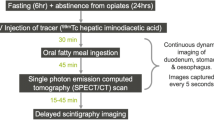Abstract
Morphine intervention in cholescintigraphy decreases imaging time to diagnose acute cholecystitis. Not infrequently we observe duodenogastric reflux during scintigraphy with and without morphine intervention. To evaluate occurrence of duodenogastric reflux related to morphine, we reviewed 55 patients who underwent cholescintigraphy with (32) and without (23) morphine intervention. Morphine was injected when there was bowel activity with non-visualization of the gallbladder at 60 min. Duodenogastric reflux was identified by the appearance of activity in the area just below or immediately adjacent to the tip of the left hepatic lobe laterally. Among 32 patients with morphine intervention, 19 had acute cholecystitis and 13 chronic cholecystitis. Eleven of 19 (58%) with acute cholecystitis had duodenogastric reflux and 6 of 13 (46%) had duodenogastric reflux in chronic cholecystitis. The total of duodenogastric reflux in the group with morphine injection was 53%. Two patients’ duodenogastric reflux occurred before morphine injection and was more apparent after morphine was given. In the without morphine group, 3 had acute cholecystitis and 20 had chronic cholecystitis; 2 (one acute and one chronic cholecystitis) of these 23 (9%) had duodenogastric reflux. Our results indicate: (1) occurrence of DG reflux in morphine augmented cholescintigraphy is not significantly different in cholecystitis from that in chronic cholecystitis; (2) duodenogastric reflux in morphine augmentation occurs significantly more often than without morphine intervention (p < 0.001). We conclude that cholescintigraphy with morphine enhances duodenogastric reflux. The degree of duodenogastric reflux in the acute cholecystitis patients has been more severe than in the chronic cholecystitis patients.
Similar content being viewed by others
References
Choy D, Shi EC, McLean RG, et al. Cholescintigraphy in acute cholecystitis: use of intravenous morphine.Radiology 151: 203, 1984.
Oates E, Achong DM. Incidence and significance of enterogastric reflux during morphine augmented cholescintigraphy.Clin Nucl Med 17: 926–928, 1992.
Shih WJ, Coupai JJ, Domstad PA, et al. Disorders of gallbladder function related to duodeno-gastric reflux in technetium-99m DISIDA hepatobiliary scintigraphy.Clin Nucl Med 12: 857, 1987.
Freitas JE. Cholescintigraphy in acute and chronic cholecystitis.Semin Nucl Med 12: 18, 1982.
Shih WJ, Fockele DS. Enterogastric reflux demonstrated by radionuclide hepatobiliary scintigraphy.Semin Nucl Med 20: 367, 1990.
Wang GX, Shih WJ, Tang PL, et al. Duodenogastric reflux demonstrated by cholescintigraphy in peptic ulcer disease and chronic gastritis.Clin Nucl Med 19: 100–103, 1994.
Mackie CR, Wisbey ML, Caschieri A. Milk Tc-99m EHIDA test for enterogastric: bile reflux.Br J Surgery 69: 101–104, 1982.
Mack MJ, Slavin JD, Spencer RD, et al. Two false negative results using morphine sulfate in hepatobiliary scintigraphy.Clin Nucl Med 14: 87–88, 1989.
Tolin RD, Malmud LS, Stelzer F, et al. Enterogastric reflux in normal subjects and patients with Billrowth II gastroenterostomy.Castroenterology 77: 1027, 1979.
Drane WE, Hanner JS. Complete duodenogastric reflux: A sign of significant duodenal pathology.J Nucl Med 301: 1568–1570, 1990.
Dufresne F, Carrier L, Gagnon M, et al. Scintigraphic study of duodenal-gastric reflux in cases of primary gastropathy, chronic ulcer of the duodenal bulb, and Moynihan’s disease.J Nucl Med 29: 17–22, 1989.
Boureakas EC, Tupler RH, Turbiner EH. Morphine-augmented cholescintigraphy with a false-negative result and an apparent ectopic gallbladder.Clin Nucl Med 17: 931–932, 1992.
Yeo EE, Low JC, Azizi F. False-negative morphine-augmented cholescintigraphy in a patient with gangrenous cholecystitis.Clin Nucl Med 17: 929–930, 1992.
Jaffe JH, Martin WR. Opioid analgesics and antagonists.In The pharmacological basis of therapeutics, Gilman AG, Rall TW, Nies AS, Taylor P (eds.), 8th ed., Elmsford, NY, Pergamon Press, pp. 485–521, 1990.
Kim EE, Pjura G, Lowry P, et al. Morphine-augmented cholescintigraphy in the diagnosis of acute cholecystitis.AJR 147: 1177, 1986.
Author information
Authors and Affiliations
Rights and permissions
About this article
Cite this article
Shih, WJ., Lee, JK., Magoun, S. et al. Morphine-augmented cholescintigraphy enhances duodenogastric reflux. Ann Nucl Med 9, 225–228 (1995). https://doi.org/10.1007/BF03168405
Received:
Accepted:
Issue Date:
DOI: https://doi.org/10.1007/BF03168405




